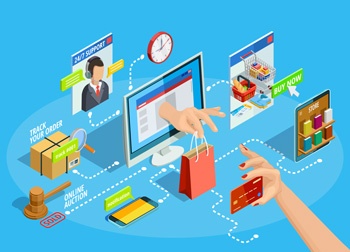It’s no secret that customers expect a seamless and personalized experience, whether interacting with a company via a mobile device, computer, in-store, or on the phone with a customer service representative. As consumers (and B2B customers) ourselves, we have little—if any—patience for inconsistent information and impersonal interactions.
Order Management Experiences
This not only applies to our shopping and purchasing experiences, but to our post-purchase experience as well: timeliness and accuracy of order status updates, if our order was delivered or available for pick up as promised, the quality of our interactions with representatives, and the ease of returning items.
Sounds obvious, but if you’re reading this blog post, you understand that meeting these expectations consistently is no small feat. Delivering flawless omnichannel shopping and post-purchase experiences can be exceedingly complex from technology, process, and training perspectives—especially for companies with multiple business models and brands, multiple marketplaces, a large number of items, and numerous store locations, warehouses, distribution centers, and fulfillment partners.
An omnichannel order management system (OMS) can play an essential role in meeting these expectations. Today’s sophisticated order management and fulfillment systems are capable of much more than capturing an order through and sending it to a back-end system for processing. Some can meet a wide range of customer demands, orchestrate order fulfillment across channels, facilitate an experience that engenders customer loyalty, and assist in maximizing profits for the company as well. In addition, these systems can provide critical business data to better inform decisions surrounding merchandising, returns, inventory, marketing, and other functions.
Most likely, if you are selling products online, you are already employing some sort of an order management system. It might be part of your ecommerce platform, ERP, or CRM system—or perhaps a home-grown, proprietary solution. However, as you may have recognized, these systems often fall short of meeting customer expectations.
If this is the case—and you want to improve the customer experience by leaps and bounds—consider some of the most critical components of an omnichannel order management system as you evaluate your options. Here are some questions you should be asking.
Can the Order Management System Capture Orders Across Channels?
Whether a customer wants to order online, by phone, in-store, or through a mobile application, the OMS should be able to capture it through one centralized system. Think of all the different ways consumers and B2B customers want to shop, purchase, and receive their items. For example, they want to buy online and ship to their home, buy online and pick up in-store, order in-store and have it delivered if the product is sold out, or add onto an existing order when on the phone with customer service. Now think about further complexities as we add Marketplaces such as Amazon, eBay, Newegg, and others to the mix. A single customer may initiate any combination of these, and your OMS should support all scenarios.
Make sure the system can integrate with your front-end ecommerce platform, various Marketplaces, etc. to capture orders via the website or mobile site. In addition, you’ll want to make sure that the OMS empowers contact center representatives and store associates to easily enter orders, look up and add to existing ones, and make changes as requested as well.
Can it Route Orders Intelligently to the Best Fulfillment Source?
The OMS should be able to route the order to the best source(s) for fulfilling each item in the order—including warehouses, stores, in-transit inventory, distribution partners, etc.—to ensure customers receive their items quickly and cost-effectively. For example, a customer may order an item that is not in stock at the main warehouse but is in stock at a store. The OMS system can apply business rules to route the order to the store for processing and shipping to the customer.
For cases where a single order contains an assortment of items that are best fulfilled through different stores or warehouses, it should be able to break the order into its individual line items, and route each item to the right source for fulfillment. Regardless of how many sources are involved in fulfilling the order, the system should be able to provide the order status information and updates as well.
Does It Provide Accurate Inventory Visibility at All Touchpoints?
Customers expect accurate inventory information to be visible at all touch points. To provide this, it’s important for all channels to have access to shared, up-to-date inventory availability for in-stock, in transit, and backordered product wherever they are—warehouses, distribution partners, and stores. Integration between the OMS and other systems, such as ERP, WMS, and POS, is essential for enabling this level of global inventory visibility.
Is My Company’s—and My Customers’—Data Protected?
Nobody wants to be included in the next big data breach splashed all over the news. Breaches are preventable with the right controls. In an order management system, this includes defined user roles and privileges, as well as SSL encryption and authentication for APIs.
Can the Order Management System Process and Track Returns Across Channels?
It’s inevitable: customers will need to return items, and how smoothly that goes is an important part of the customer experience. Your omnichannel order management system should have reverse logistics or returns management capabilities make it easy for them to return items via their preferred method and receive timely refunds or credits. It should also orchestrate the return to the right location and provide visibility into the status of the return.
Does It Provide You with a 360-Degree View of Customer Orders?
The seamless, personalized experience customers expect requires a 360-degree view. Essential to providing this is centralized, comprehensive data about customer orders, purchasing history, and preferences from all touchpoints. This requires integration between the OMS and other systems such as ecommerce platforms, POS, ERP, and CRM systems where this data resides. Whether the customer is purchasing, returning, or exchanging—online or in the store—the order management system should track all of this activity and make this information available to authorized retail employees and customer service reps to facilitate purchases and returns.
Can It Be Customized for My Unique Business and Customer Needs?
Your business and relationship with its customers are unique, and while you’ll want a product with some preconfigured, ready-to-go options, you’ll also want to customize reporting, business rules, information flows, locations, partners, and key performance indicators (KPIs). Not every order management system out there is so flexible—which can lead to numerous headaches down the road.
As My Business Grows, Will It Grow with Me?
Technology changes quickly, as does your business and its customers. What may work well today for managing your orders may not be sufficient in the years ahead. Whatever OMS you choose needs to handle not only today’s transaction volume but also projected growth. It should also enable you to add more order capabilities and channels with a reasonable effort to better serve your customers in the future.
Can It Help You Avoid Disruptions?
Disruptions lead to disappointments for your business and customers. Leveraging visibility into all sources of inventory, an order management system can help predict when supply disruptions will impact promised delivery dates. Ideally, it can alert the right individuals, locate the best alternative source of supply, and reroute the order when there is a lack of supply. Furthermore, it should provide (or feed into) analytics to help to make informed decisions to avoid disruptions going forward. If the OMS can’t provide this on its own, make sure there is a complementary solution available to provide this.
Are the Right Resources Available to Help?
The omnichannel journey can be daunting with many pitfalls along the way. Even the largest, most established retailers and brands have faced challenges around omnichannel order fulfillment. The OMS platform you choose is very important, but how effectively it is designed, implemented, and optimized for your business and its customers is critical as well.
Your OMS Partner
Work with a partner that not only has in-depth experience with the OMS, but also understands your industry, processes, and goals very well. A long-term relationship built on trust is key. Ideally, they have assisted companies very similar to yours, and are able to draw upon best practices learned. Working with the right partner can help you save you time and money, avoid disruptions and pitfalls, streamline processes, identify new revenue opportunities, and deliver customer experiences that differentiate your business in the marketplace.
We’ll explore these areas further in future blog posts. In the meantime, we recommend checking out this white paper from analyst firm FitForCommerce to learn more on this topic.

